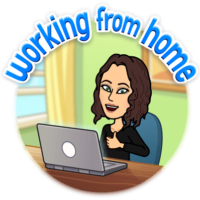
As requested by educators, I began creating lessons that align to a lesson design process I had developed specifically for remote/distance learning. The distance learning protocol of Set the Stage, Content, Collaboration, Synthesize Learning resonated with educators who sought examples of what this may look like. As schedules allowed outside of my day job, I spent time beginning to fill out the lesson plan according to student learning goals in alignment with specific grade levels/content areas. (See remote/distance learning page for more details of each stage of the lesson design process.)

The lesson example bank continues to grow, and I plan to continue developing additional content this coming week during my days off. Feedback from educators has been very positive. This being said, it is vital that we continually seek to refine the resources we produce for those we serve. Conversations with colleagues made me realize the need to further iterate.
Learning Environments are Variable
In a traditional classroom setting, educators have some control over the learning environment. They have the ability to alter lessons to meet their needs in regards to schedules and classroom set-up in addition to other factors. In distance learning, the environment is much more variable. Home environments differ across a group of students, even if they live in the same community. Some students may have parents that are working from home, others may stay with a relative or older sibling when their parents work at a job considered essential. A few may struggle to find a quiet place to focus on learning, their classmates may live in a household in which parents face financial challenges due to layoffs as a result of the recent pandemic.
Simplicity Increases Accessibility
As such, I came to the realization that my audience is not merely educators, but families and students as well. An educator will understand a lesson design example. A parent, older sibling, or student may not. As educators, we sometimes forget that those we serve may not speak our language. In this distance learning environment, it is vital that we design learning activities that are accessible. My first iteration of lesson example resources was to add a digital slidedeck (printable to increase access for those without reliable internet and/or a device) to be distributed in alignment with the lesson plan. While the learning activities called for on the slidedeck are designed purposefully to be pedagogically sound, reflect the neuroscience of Universal Design for Learning, and promote the 4 C’s, these details are unnecessary for the majority of parents. Simplicity is key.

Better Together
A colleague of mine added an additional layer of support to the idea of a simple slidedeck. She reminded me that many educators are overwhelmed just as their students’ families may be. These educators may be working from home with young children in the home, and/or a spouse or family member’s income may have been affected by quarantine. Educators need simplicity during this time as well. My colleague’s idea was to add notes for the teacher in the speaker notes of the slidedeck. This way, there is only one document to view. A link to the lesson plan text may be included for those interested, but it is not a necessary extra step in the process of viewing a learning experience they may wish to use or adapt for the students they serve. This is another iteration I will be working on this week during spring break.
As we seek to support those in our midst, whether they be students or educators, it is vital that we remember the variability in their home environments. In designing distance learning, it is more important than ever that we provide open-ended opportunities that can meet the needs of our learners’ individual contexts.
Click here to visit the remote/distance learning page for more resources.
